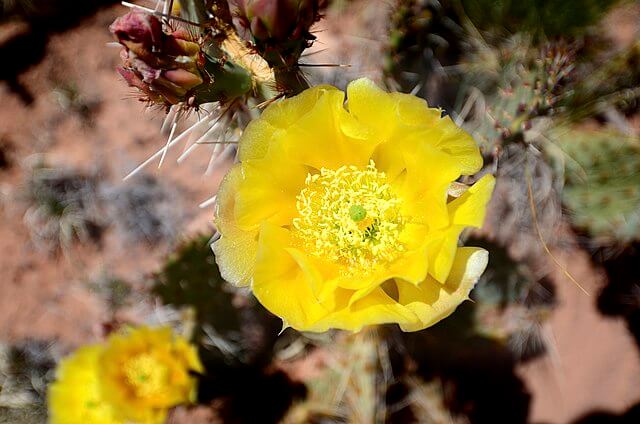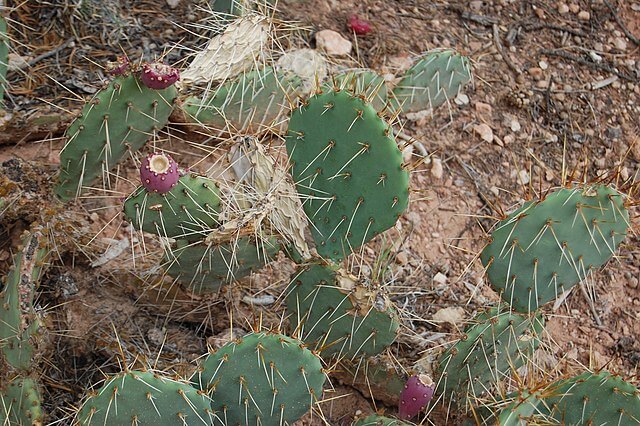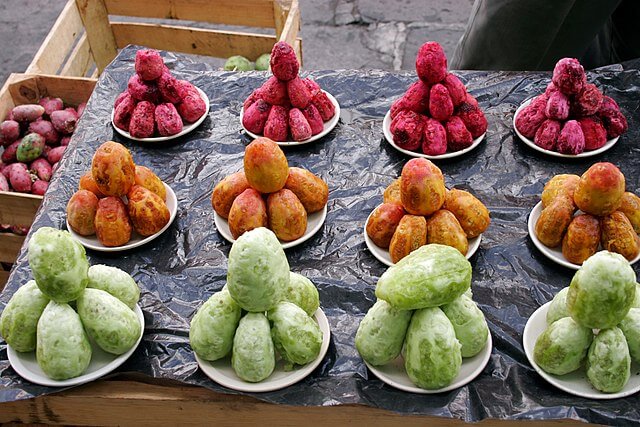The Opuntia Columbiana, also known as the Prickly Pear cactus, is a perennial plant that grows in northeast Oregon and eastern Washington. Other names the Prickly Pear cactus is also known by are Oldman Prickly pear and Columbia River Pricklypear. The Prickly Pear cactus isn’t far from home, as this plant is native to the western Washington state, and is most commonly found on the San Juan Islands. This variety of cactus is a perennial plant that grows best in areas that have access to either full sun or partial shade. When identifying, be positive of your identification, as Opuntia means “prickly pear”, and there are over 40 varieties currently known.

However, all Opuntia are edible. The Opuntia Columbiana has yellow flowers and can be eaten as a fruit, which is popular in other parts of the Americas. This fruit can be found in different colors, featuring shades of red, green, or light orange. The raw leaves containing high levels of water, and the fruit itself has been used in many ways in the culinary world, including salads, desserts, and main entrees, to name a few. Found in the young versions of the fruit are stems, referred to as nopales, which are also edible, but have been used as a cheaper alternative to corn in tortilla production. Often referred to as a sweet and juicy food, the fruit from the Prickly Pear cactus can substitute other fruits in dishes, or be eaten raw when prepped correctly.

When preparing the cactus for eating, the first and most easily notable precaution to take is the spines. The spines on Opuntia varieties can be quite small and can cause irritating wounds, as they easily embed in one’s skin. When gathering this cactus variety, make sure to bring a sharp knife and heavy-duty gloves. Tongs might also be helpful to maintain a safe distance when harvesting. When you are ready to start preparing your Prickly Pear fruit, run the cactus under running water, and use a fork and tongs to hold the cactus pieces in place, then take your sharp knife and scrape the spines off. In case some of the spines are more stubborn, a pair of tweezers might be needed.
You do not have to cook Prickly Pear cactus to enjoy the fruit or the nutritional benefits. Prickly Pear cactus is often freshly prepped and cut, then frozen to enjoy in hotter weather. The remaining pads, the green exterior that protects the interior fruit, can also be used once de-spined and eaten raw or cooked (although it is preferred to eat the nopales raw). Think of a texture similar to okra or green beans when you think of the texture of the raw cactus nopales. When cooked, the nopales will have a taste also similar to green beans, and becoming slightly slimy as well. When consumed raw, the Prickly Pear cactus is a good source of vitamin A (17%) and Magnesium (24%) and is also a hydrating plant with 88 grams of water contained within the plant itself.
Other nutritional benefits from eating Prickly Pear cactus include improved digestion from the plant’s fiber and potassium levels, cardiovascular improvement due to antioxidant levels, and other trace vitamins and minerals that are overall beneficial to health. Other vitamins and minerals found in this cactus include amino acids, fatty acids, Vitamin E, Vitamin K, beta-carotene, and phosphorus, among other important phytochemicals.
In Mexico, Prickly Pear fruit, specifically the juice and pulp, was used in folk medicine to treat urinary tract infections, inflammation, and general wounds. Other uses that this plant has been used for includes dye, faux leather, and fuel.
Luckily, the other varieties of Opuntia are edible, but some are simply unpalatable when eaten, so to be sure your efforts of preparation are worth the while, be certain of your identification. Again, preparation is highly important as you want to avoid accidentally eating the spines to avoid stomach and mouth injuries. The seeds found within Opuntia can also cause constipation if eaten in large quantities.
Prickly Pear cactus is a great edible option that can be grown in the right conditions, or found in the wild on the west coast. Because of the trickiness of harvesting this variety of plants, however, it might be a good idea to test out your likeness for Prickly Pear cactus by purchasing a pad or two when and where you are able. However, if you are ready to tackle harvesting, then make sure to try out eating both parts in different ways to experience the interesting diversity that Prickly Pear cactus has to offer.

Written by Jordyn Lee
Jordyn Lee is a freelance writer with a background in herbalism and a passion for sustainable living. She has a Bachelor's degree in Communication Studies and continues to learn more about health and nature. Connect with her on (LinkedIn) or Freelancer Profile (upwork.com).
Many of our readers find that subscribing to Eat The Planet is the best way to make sure they don't miss any of our valuable information about wild edibles.
See our privacy policy for more information about ads on this site






